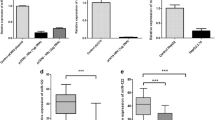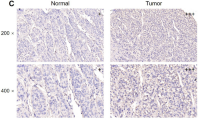Summary
To observe the alteration in the expression of DNA repair enzymes hOGG1 and hMYHα and the change in 8-OHdG levels in the HBx gene-transfected cells HepG2/HBx and to explore the mechanisms of the HBV-associated hepatocellular carcinoma, the gene-transfected cells HepG2/HBx which stably expressed HBx was established, and the effect of HBx on the cell cycle and proliferation of HepG2 was examined. By using the β-actin as the interior control, real-time polymerase chain reaction (Real-time qPCR) was employed to quantitatively detect the expression of DNA repair enzymes hOGG1 and hMYHα in the HepG2/HBx, the control cells HepG2 and HepG2 transfected with pcDNA3.1 vector (HepG2/pDNA3.1). The 8-OHdG levels were determined by HPLC/ECD in the established gene-transfected cells HepG2/HBx and the control cells HepG2 and HepG2/pcDNA3.1. Our results showed that the expression of DNA repair enzyme hMYHα in the HepG2/HBx (0.021±0.007) was significantly lower than that of HepG2 (0.099±0.041) (P<0.05) and HepG2/pDNA3.1 (0.121±0.005) (P<0.05). However, the no significant differences existed in the expression of DNA repair enzyme hOGG1 among the three cell strains (P>0.05). The 8-OHdG level in the HepG2/HBx was significantly higher than that in HepG2 and HepG2/pcDNA3.1 (P<0.05). It is concluded that HBx gene may inhibit the expression of DNA repair enzyme hMYHα mRNA to impair the ability to repair the intracellular DNA oxidative damage, to increase the oxidative DNA-adduct 8-OHdG and to affect the nucleotide excision repair function, thus participate in the occurrence and development of hepatocellular carcinoma.
Similar content being viewed by others
References
Ganem D and Prince AM. Hepatitis B virus infection — natural history and clinical consequences. N Engl J Med, 2004,350(11):1118–1129
Marusawa H, Matsuzawa S, Welsh K, et al. HBxIP functions as a cofactor of surviving in apoptosis suppression. EMBO J, 2003,22(11):2729–2740
Wei Y, Liu D, Zhou F, et al. Identification of beta-1,4-galactosyltransferase I as a target gene of HBx-induced cell cycle progression of hepatoma cell. J Hepatol, 2008,49(6):1029–37
Xu Zh, Zhao MJ, Li TP. P73 beta inhibits transcriptional activities of enhancer 1 and x promoter in hepatitis B virus more efficiently than P73 alpha. World J Gastroenterol, 2002,8(6):1094–1097
Su F, Theodosis CN, Schneider RJ. Role of NF-κB and Myc proteins in apoptosis induced by hepatitis B virus HBx protein. J Virol, 2001,75(1):215–225
Ahn JY, Jung EY, Kwun HJ, et al. Dual effects of hepatitis B virus X protein on the regulation of cell cycle control depending on the status of cellular P53. J Gen Virol, 2002,83(11):2765–2772
Arbuthnot P, Capovilla A, Kew M. Putative role of hepatitis B virus x protein in hepacarcinogenesis: effects on apoptosis, DNA repair mitogen activated protein kinase and JAK/STAT pathways. J Gastroenterol Hepatol, 2000,15(4):357–368
Jung JK, Arora P, Pagano JS, et al. Expression of DNA methyltransferase 1 is activated by hepatitis B virus X protein via a regulatory circuit involving the p16INK4a-cyclin D1-CDK 4/6-pRb-E2F1 pathway. Cancer Res, 2007,67(12):5771–5778
Lau WM, Ho TH, Hui KM. p16INK4A-silencing augments DNA damage-induced apoptosis in cervical cancer cells. Oncogene, 2007,26(41):6050–6060
Chen J, Siddiqui A. Hepatitis B virus X protein stimulates the mitochondrial Translocation of Raf-1 via oxidative stress. J Virol, 2007,81(12):6757–6760
Gao J, Chen C, Hong L, et al. Expression of Jagged1 and its association with hepatitis B virus X protein in hepatocellular carcinoma. Biochem Biophys Res Commun, 2007,356(2):341–347
Gao J, Song Z, Chen Y, et al. Deregulated expression of Notch receptors in human hepatocellular carcinoma. Dig Liver Dis, 2008,40(2):114–121
Purow BW, Haque RM, Noel MW, et al. Expression of Notch-1 and its ligands, Delta-like-1 and Jagged-1, is critical for glioma cell survival and proliferation. Cancer Res, 2005,65(6):2353–2363
Lupberger J, Hildt E. Hepatitis B virus-induced oncogenesis. World J Gastroenterol, 2007,13(1):74–81
Ganem D, Prince AM. Hepatitis B virus infection — natural history and clinical consequences. N Engl J Med, 2004,350(11):1118–1129
Marusawa H, Matsuzawa S, Welsh K, et al. HBxIP functions as a cofactor of surviving in apoptosis suppression. EMBO J, 2003,22(11):2729–40
Tanaka Y, Kanai F, Kawakami T, et al. Interaction of the hepatitis B virus X protein (HBx) with heat shock protein 60 enhances HBx-mediated apoptosis. Biochem Biophys Res Commun, 2004,318(2):461–469
Hoare J, Henkler F, Dowling JJ, et al. Subcellular localisation of the x protein in HBV infected hepatocytes. J Med Virol, 2001,64(4):419–426
Tang H, Oishi N, Kaneko S, et al. Molecular functions and biological roles of hepatitis B virus x protein. Cancer Sci 2006,97(10):977–983
Luna L, Rolseth V, Hildrestrand GA, et al. Dynamic relocalization of hOGG1 during the cell cycle is disrupted in cells harbouring the hOGG1-Cys326 polymorphic variant. Nucleic Acids Res, 2005,33(6):1813–1824
Arai K, Morishita K, Shinmura K, et al. Clonging of a human homolog of yeast OGG1 gene that is involved in the repair of oxidative DNA damage. Oncogene, 1997,14(23):2857–2861
Paz-Elizur T, Krupsky M, Blumenstein S, et al. DNA repair activity for oxidative damage and risk of lung cancer. J Natl Cancer Inst, 2003,95(17):1312–1319
Sheehan AM, McGreor DK, Patel A, et al. Expression of human 8-oxoguanine DNA glycosylase (hOGG1) in follicular lymphoma. Morden Pathol, 2005,18(11):1512–1518
Hagiwara A, Kitajima Y, Sato S, et al. Allelic loss of the DNA repair gene OGG1 against oxidative damage in esophageal squamous cell carcinoma. Oncol Rep, 2005,13(6):1009–1016
Jiang Z, Hu J, Li X, et al. Expression analyses of 27 DNA repair genes in astrocytoma by TaqMan low-density array. Neurosci Lett, 2006,409(2):112–117
Cheng B, Tian DA. The effect of the Expression of DNA repair enzymes and 8-hydroxy-2′-deoxyguanosine(OHdG) in the hepatocarcinogenesis. Chin J Digest (Chinese), 2005,25(7): 437–439
Benn J, Schneider R. Hepatitis B virus HBx protein deregulates cell cycle checkpoint controls. Proc Natl Acad Sci USA, 1995,92(24):11215–11219
Lee AT, Ren J, Wong ET, et al. The hepatitis B virus X protein sensitizes HepG2 cells to UV light-induced DNA damage. J Biol Chem, 2005,280(39):33525–33535
Nyaga SG, Lohani A, Jaruga P, et al. Reduced repair of 8-hydroxyguanine in the human breast cancer cell line HCC1937. BMC Cancer, 2006,6:297
Mambo E, Chatterjee A, de Souza-Pinto NC, et al. Oxidized guanine lesions and hOGG1 activity in lung cancer. Oncogene, 2005,24(28):4496–4508
Author information
Authors and Affiliations
Corresponding author
Additional information
This project was supported by a grant from the National Natural Sciences Foundation of China (No. 30570821).
Rights and permissions
About this article
Cite this article
Cheng, B., Guo, X., Zheng, Y. et al. The effects of HBx gene on the expression of DNA repair enzymes hOGG1 and hMYHα mRNA in HepG2 cells. J. Huazhong Univ. Sci. Technol. [Med. Sci.] 29, 187–192 (2009). https://doi.org/10.1007/s11596-009-0210-5
Received:
Published:
Issue Date:
DOI: https://doi.org/10.1007/s11596-009-0210-5




